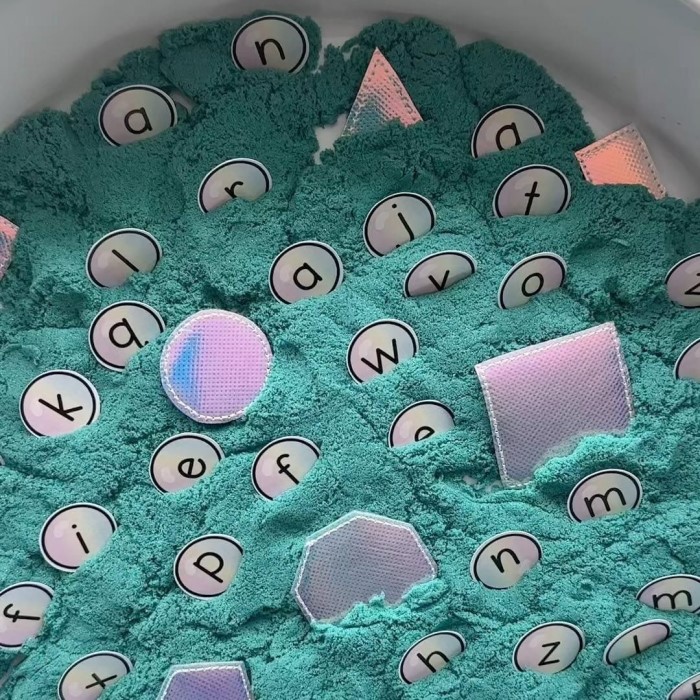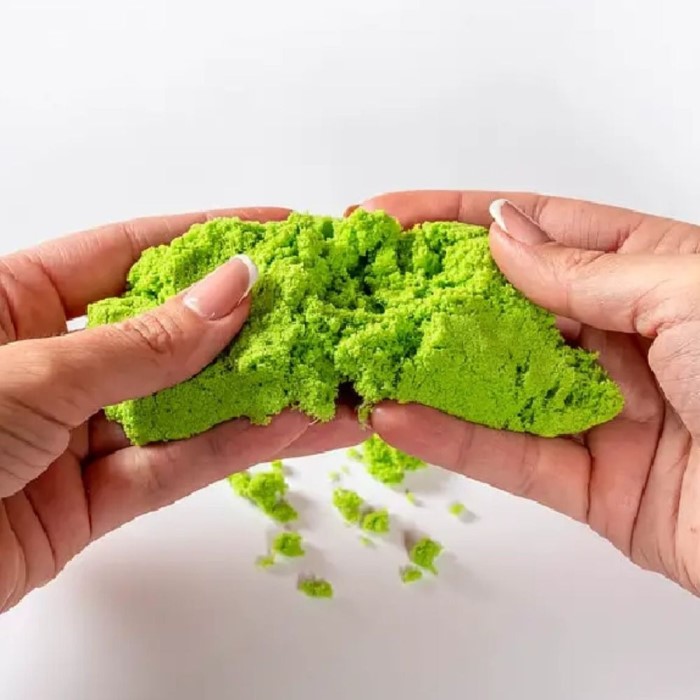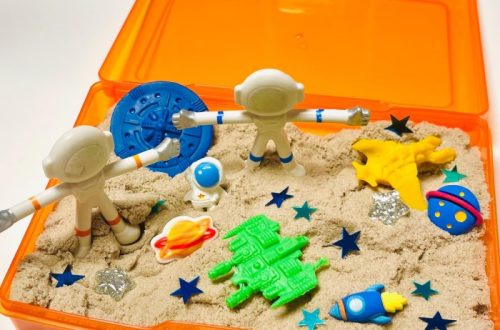What is Kinetic Sand?
Kinetic sand is a unique play material. It feels soft and stretches easily. It is moldable, allowing you to shape it without making a mess. This makes it great for long-term use. Is kinetic sand magnetic? The sand is made with regular sand coated in a safe, non-toxic polymer. This coating gives kinetic sand its unique properties. It sticks together but doesn’t stick to your hands or surfaces. This makes it easy to clean up.
Kinetic sand is used for fun, creative activities. Children love it for sensory play and building. Adults use it for stress relief and relaxation. It’s an exciting hybrid of sand and clay, combining the benefits of both. It encourages imagination and fine motor skill development in kids.

Kinetic sand is available in different colors and themes. These variations make it an even more engaging play material. It has grown in popularity due to its safety and versatility.
How Does Kinetic Sand Work?
Kinetic sand has unique properties that make it fascinating to play with. Its secret lies in the polymer coating, which alters regular sand. This coating makes the sand stick to itself, allowing it to hold shapes easily.
The Role of Polymers
Polymers are special chemicals added to kinetic sand. They bond with sand particles, creating flexibility and smooth movement. When touched, the sand feels soft and flows like liquid, yet it can be molded into solid shapes.
Behavior and Movement
When you squeeze kinetic sand, it compresses like dough. Once released, it crumbles effortlessly. Unlike regular sand, kinetic sand retains its structure and doesn’t scatter.
Why It Doesn’t Dry Out
The polymer coating stops kinetic sand from drying. It keeps it usable for long periods without maintenance. This consistency makes it ideal for sensory play and creative activities.
Kinetic sand works well due to its blend of chemistry and texture. These features make it a favorite for fun and relaxation.
Composition of Kinetic Sand
Kinetic sand is made from a combination of simple materials. Its basic ingredient is regular sand. The sand is finely ground to ensure smooth texture and consistency. This is the main foundation of kinetic sand.
A crucial component is the polymer coating. Polymers are synthetic substances added to enhance the sand’s properties. They make the sand stick to itself without scattering everywhere. This coating also gives the sand its stretchy, moldable texture.
The polymer used in kinetic sand is non-toxic and safe for all ages. It binds with the sand particles to create a unique texture. This bond allows kinetic sand to behave like both a solid and a liquid.
Sometimes colorants are added to kinetic sand. These provide a variety of bright, engaging colors. Play sets may also include glitter or themed accessories for added fun.
In summary, kinetic sand combines regular sand, a polymer coating, and optional colorants. This simple composition is key to its fascinating properties and widespread appeal.
Is Kinetic Sand Magnetic?
Kinetic sand is not magnetic. Its unique properties come from its polymer coating, not from magnets. The polymer coating gives the sand its sticky, moldable texture. It allows it to behave like both a liquid and solid.
Magnetic sand, on the other hand, contains magnetic particles. These particles react to magnetic fields. You can move magnetic sand using magnets. Kinetic sand does not have these properties. It does not respond to magnets or show changes near one.
Unlike magnetic sand, kinetic sand focuses on sensory and creative play. It is designed to be soft, stretchy, and fun for molding. This difference makes kinetic sand suitable for all ages, especially for children.
People often confuse kinetic sand and magnetic sand because of their names. However, their compositions and uses are very different. Magnetic sand is primarily used for science experiments and demonstrations. Kinetic sand is used for creativity and relaxation.
In conclusion, kinetic sand is not magnetic. It is safe and versatile, offering endless possibilities for play and stress relief.
Differences Between Kinetic Sand and Magnetic Sand
Kinetic sand and magnetic sand may seem similar but have key differences in their properties and uses. Here’s a breakdown of how they differ:
Composition
- Kinetic Sand: Made from regular sand combined with a non-toxic polymer coating. This gives it its stretchy and moldable texture.
- Magnetic Sand: Made by mixing sand with fine magnetic particles like iron filings. This allows it to respond to magnets.
Behavior
- Kinetic Sand: Soft, stretchy, and moldable. It compresses like dough but crumbles easily when released.
- Magnetic Sand: Clumps together under the influence of a magnet, forming structures that move and align based on the magnetic field.
Uses
- Kinetic Sand: Popular for sensory play, creativity, and stress relief. Children and adults shape and mold it.
- Magnetic Sand: Commonly used in science experiments and projects to demonstrate magnetic fields.
Interaction
- Kinetic Sand: Does not respond to magnets due to the absence of magnetic particles. Its features are solely due to its polymer coating.
- Magnetic Sand: Reacts to magnets and can be manipulated using them. This creates unique patterns and movements.
Safety and Accessibility
- Kinetic Sand: Non-toxic and safe for all ages, including young children. It’s easy to clean up.
- Magnetic Sand: Safe but not recommended for very young children due to small magnetic particles that could pose a choking hazard if ingested.
Purpose
Kinetic Sand:
- Sensory Experiences: Kinetic sand provides a unique texture that is both soft and moldable, allowing users to engage their sense of touch. It can stimulate sensory feedback and is often used in therapeutic settings to promote relaxation and focus.
- Creative Molding: The sand can easily be shaped into various forms, making it an excellent medium for artistic expression. Users can create intricate designs, sculptures, and structures, fostering creativity and imaginative play.
- Stress Relaxation: Playing with kinetic sand can be a calming activity. Its pliable nature allows for repetitive motions that can help relieve stress and anxiety. The act of molding and squeezing the sand has a soothing effect on the mind.
Magnetic Sand:
- Educational Purposes: Magnetic sand can be an effective teaching tool in educational settings. It can incorporate into lesson plans that focus on physics, chemistry, and general science, helping students grasp complex concepts in a hands-on manner.
- Interactive Science Activities: Using magnetic sand in experiments allows for interactive learning experiences. Students can explore the properties of magnetism, observe how the sand reacts to magnets, and conduct experiments that illustrate scientific principles.
- Understanding Magnetism: By playing with magnetic sand, individuals can gain a practical understanding of magnetism and its effects. This tactile experience enhances learning and retention, making abstract concepts more tangible and relatable.
Both types of sands are innovative materials with unique features. However, they serve distinct purposes. Kinetic sand is best for those seeking creative fun and relaxation. Magnetic sand is more suited for educational and scientific exploration.
Popular Uses of Kinetic Sand
Kinetic sand is versatile and appeals to people of various ages. Its unique properties make it stand out for fun, creativity, and relaxation. Here are some common ways kinetic sand is used:
1. Creative Play and Building
Kinetic sand is highly moldable, which inspires imagination and creativity. Children use it to build castles, animals, and other shapes. It provides a mess-free way to explore artistic ideas. Adults also enjoy creating intricate designs and sculptures.
2. Sensory Play for Kids
Kinetic sand offers a soothing texture for sensory play. Kids love the tactile experience of squeezing, stretching, and molding it. This activity also helps develop fine motor skills and hand-eye coordination. It’s particularly beneficial for children with sensory integration needs.
3. Stress Relief for Adults
Playing with kinetic sand can relieve stress and anxiety in adults. The smooth texture and simple movements create a calming effect. Squeezing or running fingers through the sand helps people relax and unwind.
4. Educational Learning
Teachers and parents use kinetic sand for educational purposes. It helps teach concepts like shapes, patterns, and basic building techniques. Adding numbers or alphabet molds can make learning more interactive.
5. Therapy Tool
Therapists use kinetic sand for physical and mental health therapy. It helps improve motor skills during rehabilitation. For mental well-being, it provides a relaxing focus for mindfulness exercises.
6. Decorative and Functional Uses
Kinetic sand can also be used as decor for themed parties or events. For example, it can create beach-like displays. Its pliability makes it suitable for unique centerpieces or scene setups.
7. Parent-Child Bonding
Kinetic sand fosters shared activities between parents and children. Building structures together encourages bonding and teamwork. It offers a wholesome, screen-free activity time.
In conclusion, kinetic sand is more than just a toy. It is a tool for creativity, learning, and relaxation. Its diverse applications make it enjoyable and useful for all ages.
Safety and Environmental Considerations for Kinetic Sand
Safety Concerns
Kinetic sand is designed to be safe for all age groups. It is made from non-toxic materials, which makes it safe for kids and adults. However, supervision recommend when younger children are playing with it. This prevents accidental ingestion of the sand.
Kinetic sand should not be eaten. While it is labeled as non-toxic, ingestion can still cause stomach discomfort. Keeping it away from pets is equally important, as it could be hazardous if swallowed. Always ensure children wash their hands after playing with the sand.
Allergy Considerations
Parents should check labels for any potential allergens. This is particularly important for kids with sensitive skin or chemical sensitivities. If irritation occurs, discontinue use immediately and consult a doctor.
Environmental Impact
Kinetic sand is primarily made from natural sand and recyclable materials. The polymer coating is designed to be safe and environmentally friendly. However, avoid discarding it in nature to prevent harm to ecosystems. Proper disposal should follow local waste management guidelines.
Cleaning and Hygiene
One of kinetic sand’s key benefits is that it doesn’t stick to hands or most surfaces. This makes cleaning up after play sessions easy. If sand gets on the floor, it can be collected quickly without mess. Avoid mixing kinetic sand with dirt or crumbs, as this can reduce its usability.
Storage for Longevity
Store kinetic sand in a sealed container when not in use. This will prevent contamination and prolong its lifespan. Avoid exposing it to water, which may change its texture and functionality. Keeping it in a cool, dry place will help maintain its unique properties.
By following these tips, you can ensure the safe and responsible use of kinetic sand. This will make playing with kinetic sand a fun, worry-free experience for everyone.
Storage and Maintenance Tips for Kinetic Sand
Proper storage and maintenance ensure that your kinetic sand stays usable for a long time. Follow these tips to keep it in the best condition:
1. Use Airtight Containers
Store kinetic sand in airtight containers to prevent contamination. It keeps the sand clean and ensures consistent texture.
2. Keep Away from Water
Avoid exposing kinetic sand to water. Moisture can alter its texture and make it sticky.
3. Clean Up Quickly
If sand falls on the floor or surfaces, clean it immediately. This prevents dirt from mixing with the sand.
4. Avoid Sunlight
Store kinetic sand in a cool and dry place. Direct sunlight can dry it out or change its properties.
5. Wash Hands Before Use
Wash hands before handling to avoid transferring oils or dirt onto the sand.
6. Avoid Mixing Materials
Do not mix kinetic sand with other materials. Mixing may compromise its texture and usability.
7. Handle with Care
Teach children to play gently and keep sand inside designated play areas for easier cleanup.
8. Refresh with a Few Drops of Water
If the sand feels dry, add a few drops of water. Mix it well to restore its consistency.
By following these simple storage and maintenance tips, you can prolong the life of your kinetic sand. This ensures endless hours of fun and creative play.
Conclusion: Is Kinetic Sand Magnetic?
In conclusion, the answer to the question, “Is kinetic sand magnetic?” is no. Kinetic sand does not contain magnetic properties and is safe for children to use as a tactile and creative play material. Its unique texture provides numerous developmental benefits, including fine motor skills, creativity, and sensory exploration. With its ease of use and fun applications, kinetic sand has emerged as a favorite among educational toys for children. As parents explore options for interactive play, kinetic sand stands out as a fantastic choice that combines enjoyment with learning. By understanding its properties and educating children on safe play practices, parents can ensure a rewarding experience with this engaging material.








